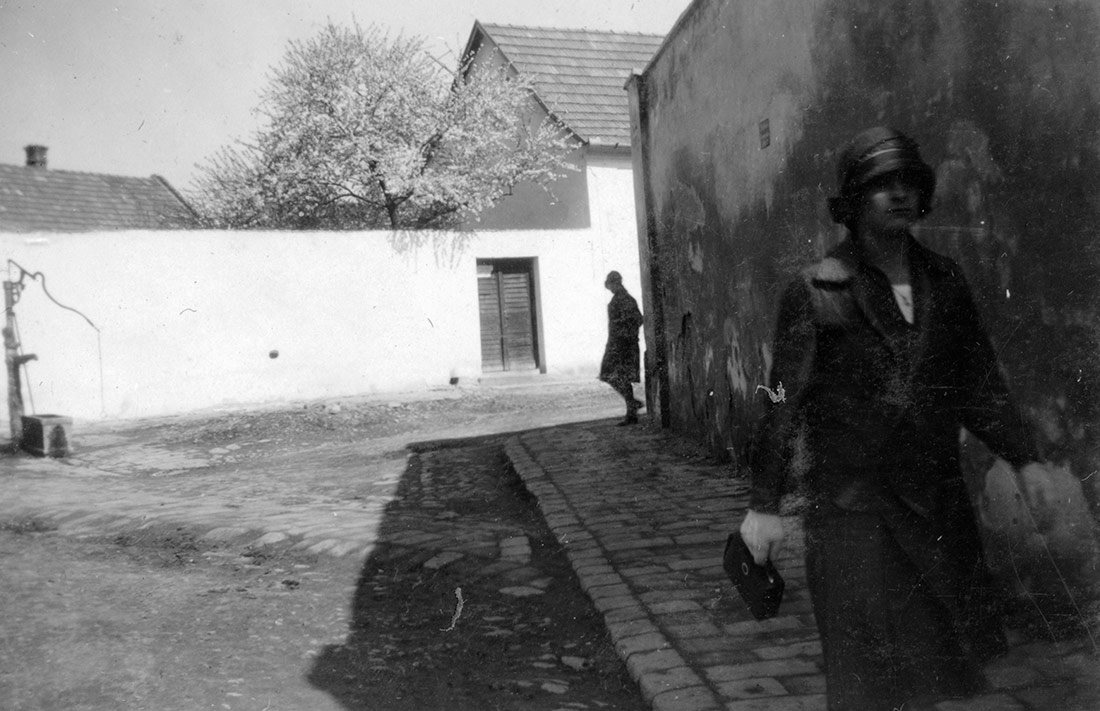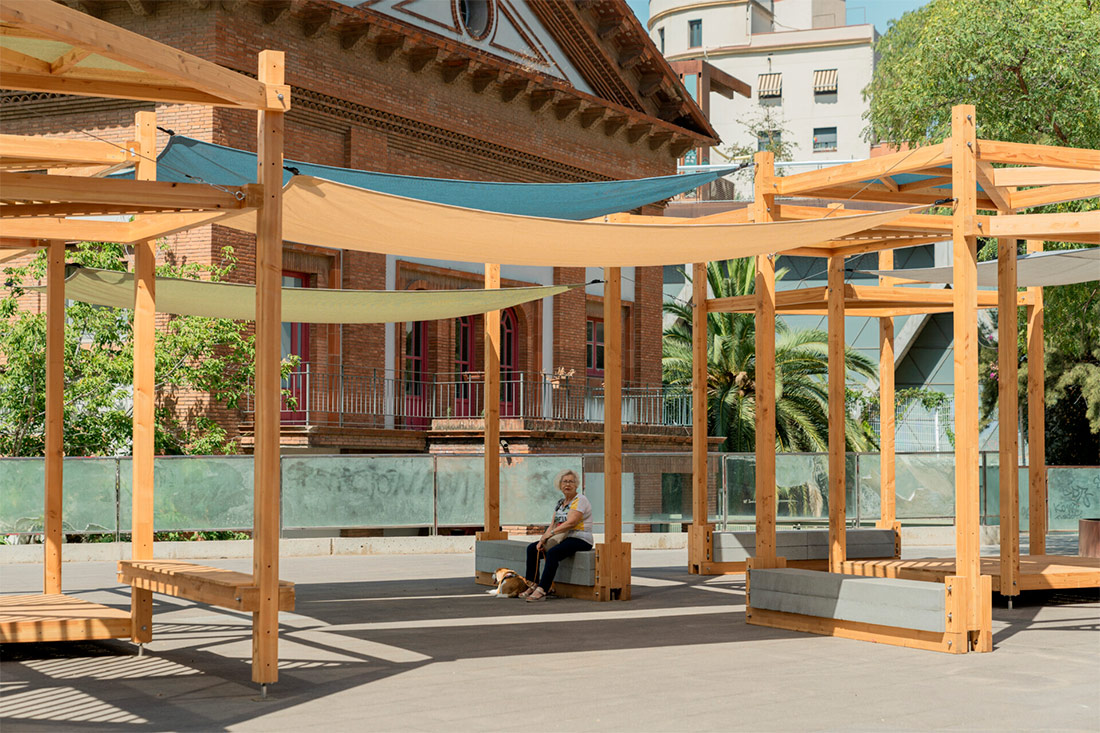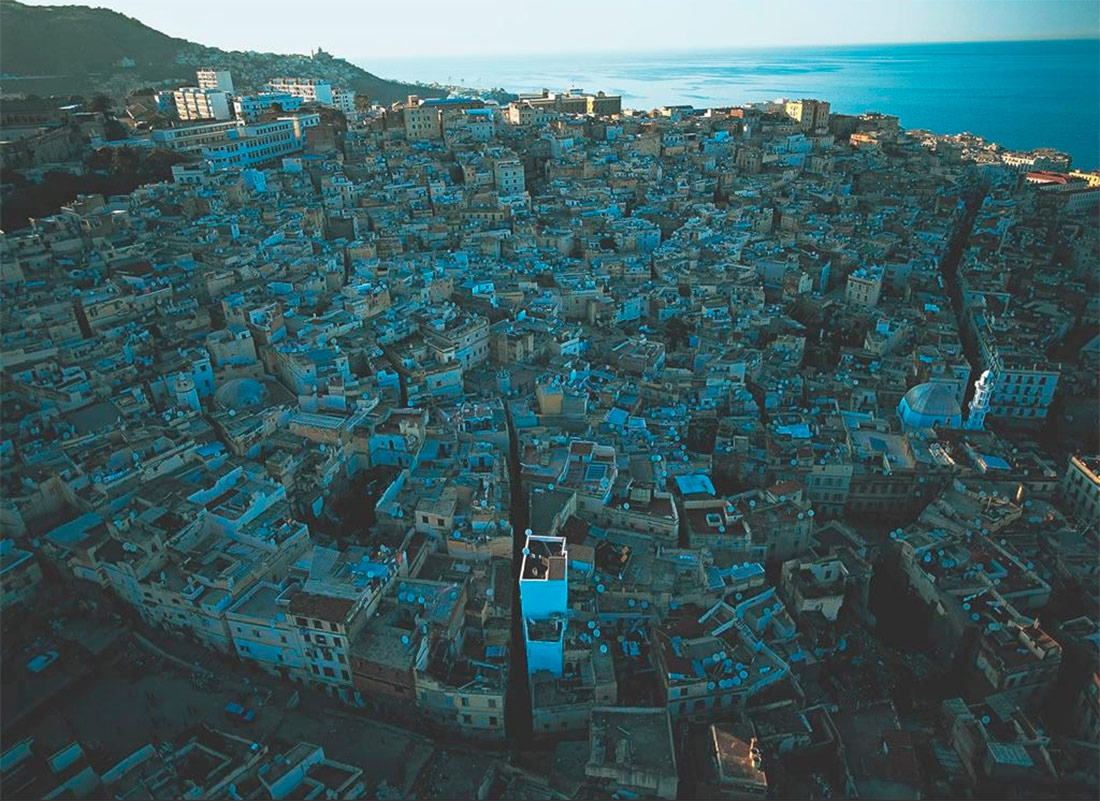
Woman walking in the shadow. Szentendre, Hungary, 1926 | Fortepan / Preisich család | Public domain
The urban architecture of modernity placed the Sun centre stage. But the dangers of over-exposure to the Sun’s rays, aggravated by the climate crisis, are forcing us to rethink public spaces and architecture from the perspective of shade.
At a time of deep environmental concerns, international and intergovernmental organisations are warning that, as human life on this planet is increasingly concentrated in urban areas, the response to the climate crisis must come from cities.[1] But the current “climatic mutation,” as Bruno Latour called it, is a time of great bewilderment, full of tentative trials and errors to conceive plural forms of planetary habitability that move us away from our dependence on fossil fuels. Something that is particularly challenging in our variegated landscape of urban infrastructures. For this reason, shaping new ideas around the concept of “caring cities,” to protect those who might be most exposed to the sometimes strangely devastating effects of uncontrolled climate change, has become our primary contemporary challenge. And this requires us to redesign our cities at the most profound level.
In recent years, in some intensely modern cities like Barcelona, we have seen how the urban space has been revitalised through the use of shade.[2] There is nothing more mundane than shade – as inhabitants of the Earth we all have a shadow, the result of our changing relationship with the Sun throughout the day as it passes over our habitats. However, this ordinary and apparently insignificant phenomenon is, in fact, highly important, as it transforms urban atmospheres, regulating exposure to solar radiation and, therefore, to heat. But the urban architecture of modernity turned its back on shade. With an impulse similar to that of Copernicus and Galileo, starting in the 19th century, hygienist urban planning placed the Sun centre stage, opening up streets and avenues and pulling down insalubrious medieval districts with dense, winding streets that were a potential focus for epidemics.
One of the many effects of this heliocentric shift in urban design was that of attributing to the star that presides over our firmament a beneficial role for public health. In his Teoría General de Urbanización (General Theory of Urbanisation) – which sets out the argument for the urban plan that transformed the city of Barcelona once and for all – Ildefons Cerdà himself states that:
The Sun is light, the Sun is health; that is why both the civilised man and the savage [sic] constantly seek it out. These brief indications suffice to understand the extreme importance in urbanisation of the exposure of the city blocks, which is what determines whether the dwellings have greater or lesser contact with the Sun’s rays, the cause and source of so many benefits.
Today, this history of positive appreciation of the sun in the city requires a counterpoint: what should we do when it harms us or puts us at risk, such as in extremely hot weather conditions or in the case of exposure leading to melanoma? Our peculiar modern “solarity” – the urban incarnation of the enlightenment ideal of total visibility – seems to impede us in taking an unprejudiced view of anything that is untouched by the sun’s rays. Thus, that which lies in the shade or the shadows is commonly understood as being hidden, pathological, archaic, conservative, dangerous or murky.[3]
However – and this is the hypothesis I would like to share here – what if we were never meant to be solar? In other words: what if, in order to relearn how to live in today’s cities, it were a question of displacing the savage power of the Sun from the centre, thus placing ourselves in the shade? A not insignificant part of life on Earth can be read as a long, interspecific story of how certain living beings have learned to shelter from the sun. This is one of the most interesting arguments in the work of palaeontologist Anthony J. Martin, who has highlighted the evolutionary importance of burrows, caves and underground shelters for the survival on Earth of many animals since time immemorial, including humans.
In this story of protection from the sun, we must not forget plants and, more particularly, trees and their key role in making the Earth habitable. In fact, many of our primordial experiences of shade and shelter from the sun come from the delicate webs of foliage woven by different trees and plants. Thinking in arboreal terms, as suggested by Shannon Mattern, allows us to hazard another hypothesis about the habitability of our planet: What would terrestrial life have been without not only the Earth’s ability to transform soil and air, but also its ability produce shaded habitats or microclimates so that certain animals could begin to crawl out of the seas?[4]
In his work on the life made possible by plants, the philosopher Emanuele Coccia proposes that we take cognizance of the enormous terraforming power of plants, which should make us think that, more than Earth itself, “we inhabit the atmosphere.” And what is the atmosphere, with its complex circulation of air, its iridescent tapestry of clouds and its intricate interrelationship with seas, rivers, mountains and forests, if not a complex interspecies system for capturing, regulating, dissipating or blocking the sun’s rays, and in which plants have always played a central role? That said, as we know, it is not only plants that transform the atmosphere, and not all atmospheric transformations are related to planetary habitability. The broad scientific and public conversation around the Anthropocene has made it possible to address how we humans also “participate in its making”: by omission and commission, in more direct or more distant ways; in our daily practices, implemented and mediated by technical instruments, but also in our consumption habits and the ways in which we build cities. In other words, we humans also participate in the modification of atmospheres through the collective practices in which we engage,[5] relating to mundane things such as our clothing, our buildings, our air conditioning systems, and also our relationship to the careful creation of shaded climates.

Prototype of In the Shade of the Mosaic | Photograph courtesy of BIT Habitat
In recent work, the importance of shade in caring for life has been highlighted by architectural historian and disability activist David Gissen, who calls for the use of shade as part of an inclusive urbanisation that considers those individuals who are often left out of the focus of urban design – the disabled, chronically ill, Black, older and young people. Shade, or rather its absence, warns us of the considerable health risks posed by the sun and heat: such as what happens to the elderly who suffer in silence from the “fatal isolation” of heat waves, or to the myriad racialised bodies that work outdoors, exposed to the scorching sun and heat.[6] But there is also an unprecedented political power lying in the shadows. In a world that is still living with the persistent stain of slavery, the Caribbean thinker of the Black radical tradition, Édouard Glissant, defended in “For Opacity” the right to opacity as a condition of survival for all those lives outside the modern enlightenment canon.
In this sense, to say that we have never been solar, and to cast our attention over the shade, therefore means disputing the design of public spaces drenched in sunlight and rethinking urbanism from the perspective of shade. But this also requires an exercise in reparation of the violence inflicted by modern society against many ancestral ways of inhabiting. In this regard, placing shade centre stage gives us a fresh perspective of what we incorrectly call “vernacular architecture,” so that we might draw inspiration from it. For what is the Mediterranean and Middle Eastern medina – that conglomerate of high adobe buildings interspersed with dampened awnings and fabrics, cool interior courtyards with vegetation and fountains – if not one great ode to shade?[7]

The Casbah of Algiers | Ladouali, Wikimedia Commons
However, we will have to go beyond the solutions of the past to think about an unprecedented future. This will force us to pay attention to the natural-cultural arrangements that manufacture different kinds of shade, their unequal conditions of access, and the related negotiation processes for the production of spaces: who is allowed to produce shade or inhabit it, and in what way, in what contexts? In this heated present, perhaps we need to transform shade from an “index of inequality” on urban inhabitation into a “mandate” that forces us to explore different arrangements of caring urbanism within planetary boundaries: air-conditioned spaces for daytime relaxation and night-time rest, bioclimatic itineraries with diverse vegetation or passively air-conditioned buildings, to give just a few examples. But to take a step further, placing shade at the centre of our explorations into urban habitability could also mean nothing less than rethinking care as an atmospheric matter.
[1] A good example of this is Chapter 6 “Cities, settlements and key infrastructure” of the 2022 report of the Intergovernmental Panel on Climate Change.
[2] For example, this seasonal shade prototyping competition organised by Barcelona City Council.
[3] The compilation Solarities: Elemental Encounters and Refractions uses the term “solarities” to describe each of the practices of relating to the Sun and its elemental planetary force, of which modern solar urbanism is just one of many.
[4] Albert, B., Halle, F. & Mancuso, S. (2019). Trees. London: Thames & Hudson; Mattern, S. (2021). “Tree Thinking”, Places Journal, September, 2021.
[5] Parikka, J. & Dragona, D. (eds.) (2024). Words of Weather. A Glossary. Athens: Onassis Foundation.
[6] Keller, R.C. (2015). Fatal Isolation: The Devastating Paris Heat Wave of 2003. Chicago: University of Chicago Press; Macktoom, S., Anwar N. H & Cross, J. (2023). Hot climates in urban South Asia: Negotiating the right to and the politics of shade at the everyday scale in Karachi. Urban Studies, 61.
[7] Kite, S. (2017). Shadow-makers: A cultural history of shadows in architecture. London: Bloomsbury Academic; Ludovico, M., Attilio, P. & Ettore V. (eds.) (2009). The Mediterranean Medina. Rome: Gangemi Editore.





Leave a comment